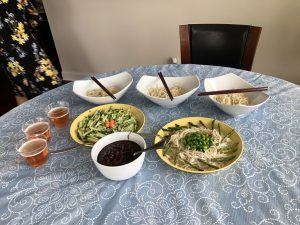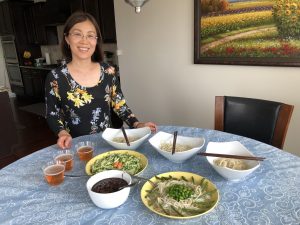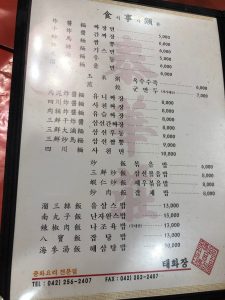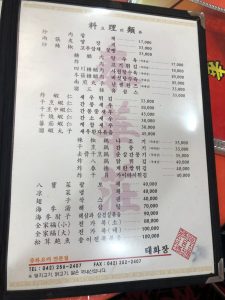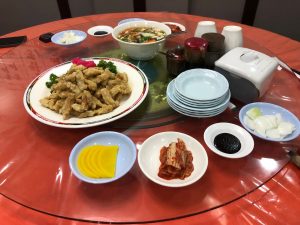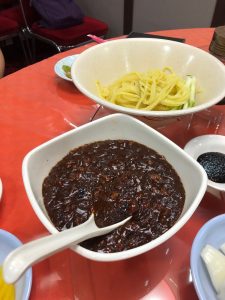Jean Lau is a 51 year-old native of Chengdu of Sichuan province in China. She moved to Huntsville, Alabama in 1991 to be with her husband, Daniel, a native of Hong Kong. Mrs. Lau had previously studied Chinese at the Sichuan University, but after her arrival in the United States, pursued a degree in accounting. In 1994, she moved to Chattanooga, Tennessee, where her husband, Daniel, had been offered a new job, and shortly after, in 1995 received her bachelor’s degree. She then went on to pursue her master’s degree in biostatistics, which she received in 2008. After a few years at home with her children, Jean took a position as a survey research analyst in the Medical Informatics division of BlueCross BlueShield of Tennessee. She also taught Chinese part-time at the Chattanooga Chinese School for more than ten years and in the after-school program at The Bright School for two. Back in China, Jean’s mother taught Chinese to middle school students for 30 years; the combination of her mother’s example and Jean’s love for the Chinese language inspired Jean to quit her job as an analyst and instead pursue a career in teaching.
My Interview with Jean Lau About Chinese Noodles
Jean Lau has been the high school Chinese teacher at Baylor School, my alma mater, since 2010. I met Jean in 2012, when I entered my third year of Chinese at Baylor School. Some of my fondest high school memories involve Mrs. Lau. For four years, she acted as my Chinese teacher, advisor, and second mom. She brought in countless authentic Chinese meals and snacks, noodle dishes included. Some of the foods she introduced us to were fully prepared, while others she brought disassembled so we could prepare them ourselves. I distinctly remember the spice of dandan mian and mala xiaomian. She brought in both of the spicy noodle dishes on multiple occasions. Although dandan mian is more well known, mala xiaomian, with its deep red color and tangy fragrance, is an equally spicy Chinese dish that I could never forget. Mala xiaomian is prepared almost like a soupier version of dandan mian, decorated with fermented vegetables and hints of peanut. Another frequent dish that Mrs. Lau brought to our class was huoguo, or “hot pot”. Although huoguo is not necessarily a noodle based dish, it can be. There was nothing like the fun of cooking our own little buffet of foods when she brought the makings of huoguo. Mrs. Lau always came prepared with a number of vegetables, shrimp, pork, dry noodles, dumplings, and more. Each student could drop these ingredients into the portable hot pot, and cook in the heated broth to our liking. There were also multiple types of pillowy textured dumplings Jean so kindly brought for us to prepare with her in class. There was spicy zhong shui jiao, a dumpling variety bathed in a spicy chili sauce that she also prepared with us. We also made the simple and traditional jiaozi, meaning dumpling, that we used to sop up Jean’s homemade shoyu, as well as huntun or “wonton” which after they were boiled, we added to Mrs. Lau’s homemade veggie broth. All of these little packages, my classmates and I constructed and consumed together, as a little family. All eleven of us had seen each other and bonded over food for four (or more) years. We were a family, and Mrs. Lau, our mother, displayed her love for us in everything she did, but especially the way in which she fed us. And this is where my love for Chinese cuisine, and noodles especially, began.
During my recent interview with Jean, I began by asking broad questions concerning the role noodles play in her family. She explained to me that although rice and noodles are equally important staple foods in Chinese culture, her family, for a number of reasons, eats noodles more often. First and foremost, her family enjoys noodle dishes more than rice. Second, she disclosed that she feels making noodles is much easier and less involved than cooking a “regular” Chinese meal. For rice based dishes, Jean states, one must prepare the rice as well as 3 or 4 other dishes to go with it. Noodles, however, leave more room for creativity; they can be as simple or complex as the creator desires. A quick noodle dish is as easy as adding premixed seasonings to plain noodles or stir frying noodles with gravy/brown sauce (da lu mian). She confessed that her go-to dish, however, is noodle soup. With from-scratch chicken or veggie broth at home, she can add noodles in a pinch. All in all, she claims that with noodles, there are so many ways to cook them so they are more fun and quite honestly, hard to ruin.
When I inquired as to whether or not she makes her own noodles, she admitted that she rarely does. Even when she makes fresh wontons and jiaozi with her student or her family, the wrappers are typically store bought. For everyday cooking, she uses the store-bought dry noodles, as it is so time-consuming to make noodles from scratch. She only makes homemade noodles once or twice a year, and only for very special occasions. She disclosed that for her, noodles are no longer a “special food”, as she and her family eat them so often as an every-day staple. However, during holidays and special occasions, noodles do play an integral role. A prime example would be the long-life noodle, and its symbolic role when it comes to birthdays. The consumption of long life noodles, whether store-bought or homemade, is a tradition that almost every Chinese family shares. The long-life noodle symbolizes longevity, so everyone must eat noodles every year on his or her birthday, just for that symbolic meaning.
She also referenced jiaozi, with which I am well acquainted, as another type of noodle with symbolic meaning. When I asked her about the meaning of jiaozi, she said “offspring from noodle”. Making jiaozi means having everyone over to participate and come together over this food that you can eat together. She furthers this point by stating that she always enjoys making jiaozi at home or in the classroom with students because the activity symbolizes the importance of family and friends. People have the opportunity to chat and update each other on life. She even ends this portion of the interview by stating that making jiaozi is a fun activity and tradition that she hopes will be carried on forever and always.
I then began to question her further in an attempt to discover the roots of her relationship with noodles. She told me that she grew up a region of southwestern China where spicy foods flourish. Furthermore, her family ate noodles, dumplings, and steamed buns more often than rice because her mother was from northern China, where noodles are more predominant. Regional effects on her mother’s upbringing, and therefore cooking, helped to shape Jean’s preference, and therefore her own cooking. Her mother worked full time as an English teacher, and yet she still had time to make dinner every day. But when she was young, she remembers that they always ate at home, for families very rarely went out and had a whole meal in a restaurant. Whether it was a daily meal or a big gathering, people always cooked and entertained their friends and family at home. In these days, however, people’s lifestyles are very different from the times when she grew up. Jean claims that even in China, you will find this less often. But despite such cultural change on a global scale, she tries her best to maintain this tradition of cooking at home.
As she had disclosed her opinions on the fast pace of life, and its effect on meal time, I found it most fitting to inquire about her opinions on the “instant noodles”, or instant ramen. She surprisingly admitted that she does in fact eat instant noodles but knows “its chemicals are not good,” and therefore must limit herself to one instant noodle meal per week. When I asked her about her opinion concerning the health impacts of regular noodles that she uses in her cooking, she responded with a message about balance. Her general principle is no matter how healthy one food is, you have to balance the portions about that food. For example, when she makes the soup noodle, she adds plenty of vegetables and broth for balance. Little modifications, like the addition of vegetables, and an occasional swap from beef or pork to chicken or turkey, help her to keep her staple meal to the health standards she maintains for herself and her family.
When I asked Jean whether or not she has experienced a change in her preferences or habits concerning the noodle, she said that she has, but not due to American cultural influences. Instead she cited that her hometown in Sichuan province is famous for its spicy food, so that is what she had grown to know and love. However, her husband is originally from Hong Kong, and therefore has very different preferences. Hong Kong cuisine is based on Cantonese style food that based in soup and lighter flavors. In order to accommodate both of their needs, she makes more soup noodles, to which she can add chili oil in order to make herself happy, and satisfy her own cravings of home.
She cited dan dan mian as the food that best embodies her place of origin in southwest China. When I inquired as to why the noodle is so well liked, she stated that the most distinguished part of dandan noodles is that it is spicy and has lots of flavor, which she believes to be the reason people, even her American students, generally like it so much. She also cited dandan noodles as her favorite recipe, which she kindly offered to me.
When I asked Mrs. Lau how important the noodle is to Chinese culture, she stated that it is not even possible to separate the two. Like rice, noodles play a very important role in the steady meals of Chinese people, herself included, now as much as ever. Noodles have clearly influenced Mrs. Lau culturally despite her relocation to the United States. The noodle is present in her daily meals, as well as her celebratory meals. Pasta, even here in the United States, is the food that serves to satify her family, as well as her cravings for home. Her culture remains embodied in the dishes she prepares, even in a pinch after a long day of working in the fast-paced American society.
Although she is not so much influenced by changes in the Chinese society, her diet has clearly been influenced by changes that have affected cuisine on a global scale. Mrs. Lau made clear that she still values home cooking, and the noodle’s role in daily meals, but a faster pace that affects so many across the globe is evident in her descriptions of noodles as “quick” and “easy”. She has not welcomed instant noodles as a replacement to traditional cooking, but clearly the lack of time effects the ways in which she prepares meals. She also mentioned “carbs”, and avoiding red meat when discussing the noodle and its health implications. Societal changes in pace, and changes in health outlooks have affected her views on noodles from a nutritional and convenience standpoint, but not a cultural one. From this, it appears the cultural DNA of the noodle seemingly remains unchanged. She still cites that dandan mian, which she makes with turkey meat rather than the traditional ground pork, takes her back to her roots in southwest China. The noodles may be dried, and her secret indulgence may be instant ramen, but the traditional noodle still remains an integral part of her family, her culture, and her very being. All in all, the noodle, despite time or place, has not lost its place in Chinese culture for my interviewee, Jean Lau.

